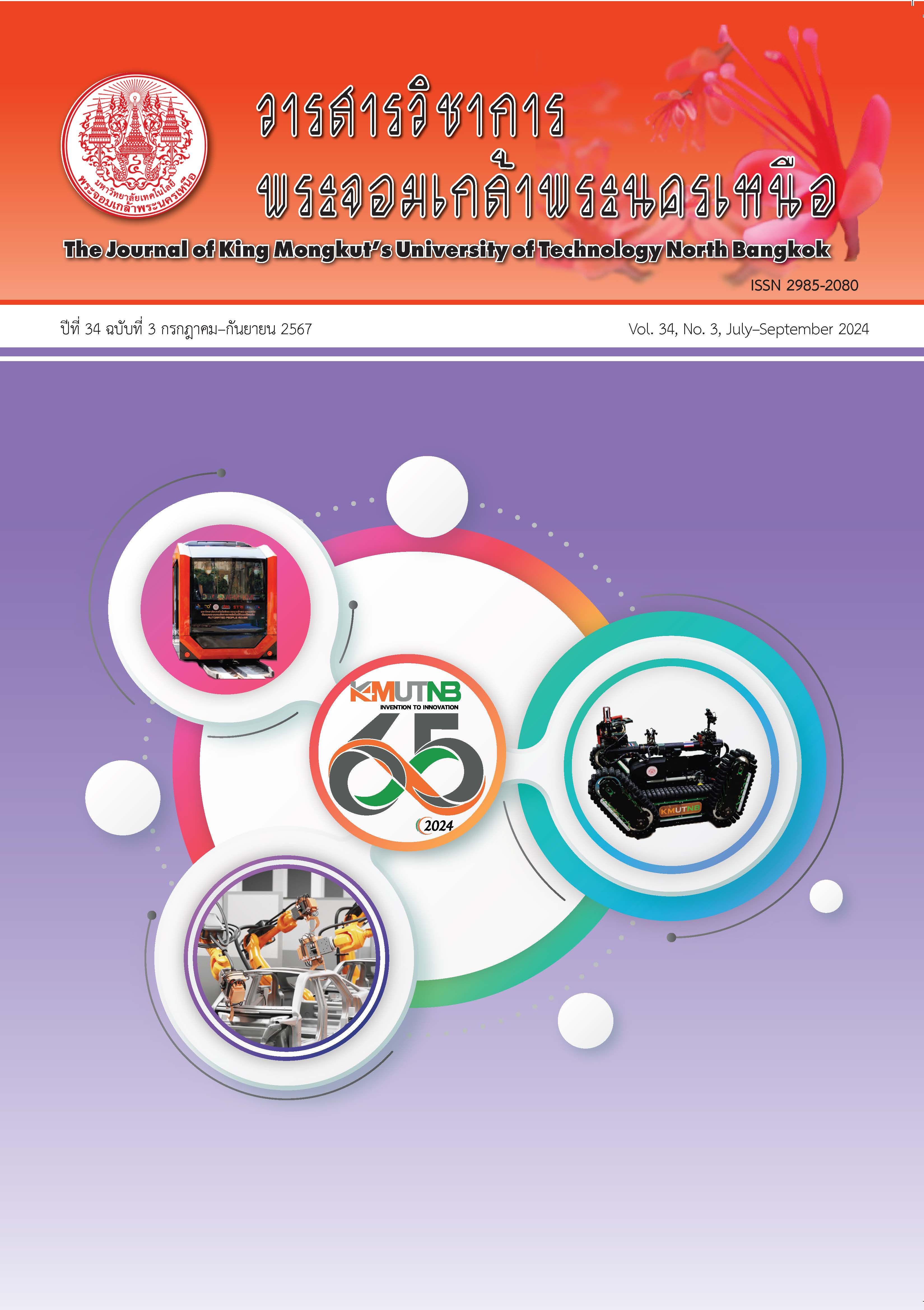Effect of Transverse Isotropy on Mechanical Properties of Phu Phan Sandstone
Main Article Content
Abstract
The objective of this study is to experimentally investigate the effect of transverse isotropy on mechanical response of bedded Phu Phan sandstone. Prismatic specimens are prepared to have bedding plane angles (β) varying from 0 to 90 degrees with the main axis. They are tested in compression under confining pressures from 0 to 12 MPa by Polyaxial load frame. The results indicate that the compressive strength is lowest when angle β is 75 degrees because failure is occurred by sliding along the bedding plane. The elastic coefficients are lowest and highest under angle β equals 0 degrees and 90 degrees, respectively. Due to grain particles are stiffen and tighten more easier in direction normal to bedding plane. Confining pressures increase the elastic moduli. The Coulomb criterion can well describe the compressive strength of the rock. Considering both stress and strain at failure, the distortional strain energy provides the results that coincide with those obtained from the Coulomb criterion. The findings can be used for analysis and design of engineering structure in transverse isotropic Phu Phan sandstone.
Article Details

This work is licensed under a Creative Commons Attribution-NonCommercial-NoDerivatives 4.0 International License.
The articles published are the opinion of the author only. The author is responsible for any legal consequences. That may arise from that article.
References
R. E. Goodman, Introduction to Rock Mechanics. 2nd ed. New York, USA: Wiley, 1989.
M. H. B. Nasseri, K. S. Rao, and T. Ramamurthy, “Anisotropic strength and deformational behavior of Himalayan schists,” International Journal of Rock Mechanics and Mining Sciences, vol. 40, no. 1, pp. 3–23, 2003.
D. Miller, R. Plumb, and G. Boitnott, “Compressive strength and elastic properties of a transversely isotropic calcareous mudstone,” Geophysical Prospecting, vol. 61, no. 2, pp. 315–328, 2013.
G. Xu, C. He, A. Su, and Z. Chen, “Experimental investigation of the anisotropic mechanical behavior of phyllite under triaxial compression,” International Journal of Rock Mechanics and Mining Sciences, vol. 104, pp. 100–112, 2018.
D. Fereidooni, G. Khanlari, M. Heidari, A. A. Sepahi, and A. P. Kolahi-Azar, “Assessment of inherent anisotropy and confining pressure influences on mechanical behavior of anisotropic foliated rocks under triaxial compression,” Rock Mechanics and Rock Engineering, vol. 49, pp. 2155–2163, 2016.
A. Veeravinantanakul, P. Kanjanapayont, A. Sangsompong, N. Hasebe, and P. Charusiri, “Structure of Phu Phan Range in the Khorat Plateau: Its apatite fission track ages and geological syntheses,” Bulletin of Earth Sciences of Thailand, vol. 10, no. 1, pp. 8–16, 2018 (in Thai).
K. Fuenkajorn, T. Sriapai, and P. Samsri, “Effects of loading rate on strength and deformability of Maha Sarakham salt,” Engineering Geology, vol. 135–136, pp. 10-23, 2012.
Standard Test Methods for Compressive Strength and Elastic Moduli of Intact Rock Core Specimens under Varying States of Stress and Temperatures, ASTM D7012-14, 2014.
J. C. Jaeger, N. G. W. Cook, and R. W. Zimmerman, Fundamentals of Rock Mechanics. Oxford, England: Blackweel, 2007.
L. Wendai, Regression Analysis, Linear Regression and Probit Regression, In 13 Chapters, SPSS for Windows: Statistical Analysis. Beijing, China: Publishing House of Electronics Industry, 2000.
B. Amadei, “Importance of anisotropy when estimating and measuring in situ stresses in rock,” International Journal of Rock Mechanics and Mining Sciences Geomechanics Abstracts, vol. 33, no. 3, pp. 293–325, 1996.
R. Gholami and V. Rasouli, “Mechanical and elastic properties of transversely isotropic slate,” Rock Mechanics and Rock Engineering, vol. 47, no. 5, pp. 1763–1773, 2014.
M. Nejati, M. L. T. Dambly, and M. O. Saar, “A methodology to determine the elastic properties of anisotropic rocks from a single uniaxial compression test,” Journal of Rock Mechanics and Geotechnical Engineering, vol. 11, no. 6, pp. 1166–1183, 2019.
L. Yun-si, Z. Xiao, and Y. Quan, “The five elastic parameters for the anisotropy of slate under the influence of different bedding orientations,” Electronic Journal of Geotechnical Engineering, vol. 1, no. 7, pp. 3695–3707, 2012.
L. G. De Vallejo and M. Ferrer, “Geological Engineering,” in Strength Criteria. CRC press, 2011.
O. Usol‘tseva, P. Tsoi, and V. Semenov, “The influence of anisotropy angle on the strength and deformation properties of artificial geomaterials and rocks,” Procedia Engineering, vol. 191, pp. 512–519, 2017.
T. Ramamurthy. Strength and Modulus Responses of Anisotropic Rocks, Oxford, England: Pergamon, 1993.
R. McLamore and K. E. Gray, “The mechanical behavior of anisotropic sedimentary rocks,” Journal of Industrial Engineering International, vol. 89, no. 1, pp. 62–73, 1967.
J. C. Jaeger, “Shear failure of anistropic rocks,” Geological Magazine, vol. 97, no. 1, pp. 65–72, 1960.
A. Bonnelye, A. Schubnel, C. David, P. Henry, Y. Guglielmi, C. Gout, A. L. Fauchille, and P. Dick “Strength anisotropy of shales deformed under uppermost crustal conditions,” Journal of Geophysical Research: Solid Earth, vol. 122, no. 1, pp. 110–129, 2017.

